You are reading the archive for the category: Classical Fencing
Filed as Classical Fencing, Destreza (Spanish swordplay), Fencing, Geek Stuff, General, Historical Fencing with Comments Off on Building a Flail Trainer
This is how we built a two-handed 3-headed flail trainer with parts you can find at your local hardware and sports store. The method described here isn’t the only way to build a flail and the training weapon here is experimental. If you build it there is every chance you could injure yourself with it if you get as crazy as my brother might. So… I warned you.
The parts list:
- 6-foot closet pole (1.8 meters)
- 2 matching screw-mounted rope hooks
- 2 bolts with matching nuts
- Nylon paracord
- Duct tape (of course)
- 3 racket balls
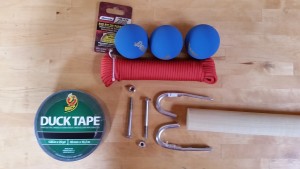
Flail parts laid out
The Measurements
Our flail has a 3-foot handle and three approximately 3-foot “chains” including the heads.
Instructions
1. Cut the closet pole down to size. (For our first flail we tried a length of 3 feet (0.9 meters). It worked fine but we’re thinking of making the next handle slightly shorter by about 4 inches for a total haft length of 32 inches (0.8 meters).)
2. Use the rope hook as a guide for marking your drill target. We chose to bring the hook as far down into the pole as possible to increase the strength of the trainer.
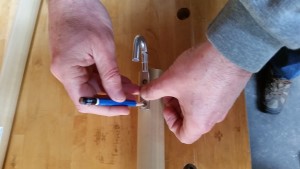
Use the Rope Hook as your Stencil for your Drill Guide
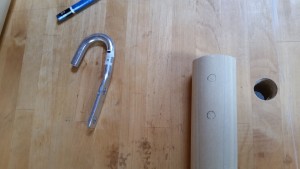
Marked and Ready for Drilling
3. Slowly drill all the way through the pole and remove any frayed edges.
4. Align the two Rope Hooks facing each other to form the “chain’s” looping anchor point on the flail. At this point you may want to remove some stock from the pole to ensure a snug fit by marking the end of the shaft and using a round file to remove the extra.
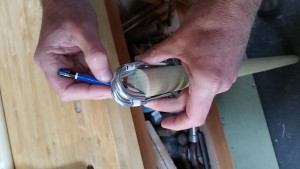
Marking the Head of the Flail to Remove Extra Stock
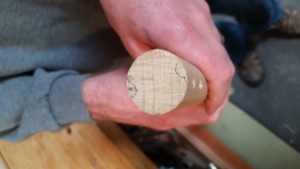
We will file that out
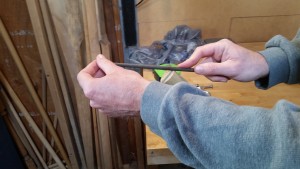
Filing out the Extra. (It’s easier if you use a vise.)
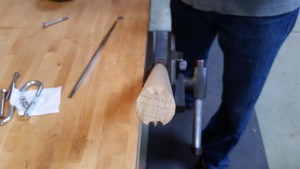
Stock Removed. Also, now it looks like the Bat symbol. (Batman would be proud to train with us.)
4. Now that you’ve created a perfect fit, fasten both Rope Hooks onto the shaft with the bolts so that they face each other to form a looping “chain” anchor point.
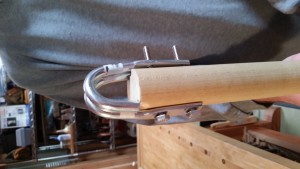
Two Rope Hooks makes a good loop.
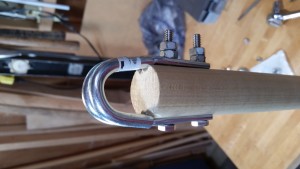
Fastened Down Tight.
5. At this point you have created something dangerous with the exposed metal bolts. I recommend using a hacksaw to cut the exposed bolts off and then cover anything with sharp edges with a layer or two of tape. You want to minimize the possibility of cutting yourself if you accidentally hit yourself in the head.
6. Next, drill a hole through each of three racket balls.

Yep… That’s a hole clean through a racket ball.
7. Run your nylon paracord through the hole. To do this, we used fishing line.
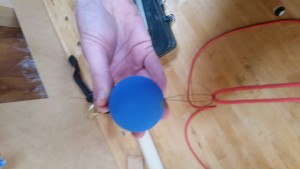
Push a loop of fishing line through the holes and then insert your paracord into the loop on the far side. Pull it through and, “Tada!” it is threaded.
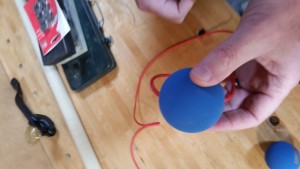
Success!
8. Tie the cord just underneath the flail head using a bowline knot. ( Click here to see how to tie this knot! )
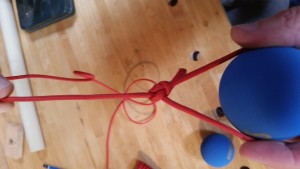
Tie it with a bowline knot.
9. Tie it to the anchor point using the same bowline knot. (Repeat the process for all three flail heads.)
10. We used duct tape on the edges of the Rope Hook to avoid any grab on the nylon rope “chains”.
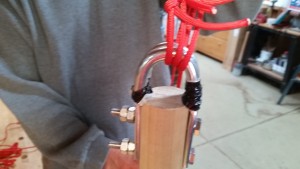
It doesn’t have to be beautiful.
The Completed Flail Trainer
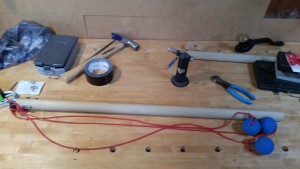
Congratulations… you have given birth to a baby flail with a 3-foot shaft and 3-foot chains.
This is much lighter than an actual flail when you swing it around but you still get a scary amount of force with it such that hitting people is probably a terrible idea. While exercising the flail we found that swinging it at high speed didn’t seem to cause any problems with the racket balls but striking solid targets caused cracks around the drilled holes which would be eventual failure points.
Still, not bad for flail 1.0.
Filed as Classical Fencing, Destreza (Spanish swordplay), Fencing, General, Historical Fencing with no replies
In July 2014 the Sacramento Sword School held its second student examination. The exam consisted solely of Scholar candidates, it was open to the public, and it was judged by a board of fencing masters with Dr. Mary Curtis acting as a special advisor to the board. In addition, this was the first time the Scholar’s examination was offered to a candidate from an external school and our we extend our fellowship and congratulations to the Elite Fencing Club in Mexico City for their candidate’s attendance and excellent performance.
To provide some context the Sacramento Sword School Scholar’s test is a La Verdadera Destreza examination derived from both the classical fencing examinations and material outlined in Don Luis Pacheco de Narvaez’s “Easy Method for examining Masters…” published in 1625. At the Scholar level the test is intended to qualify that a student has competence reflecting six months to one year of training and study. The process includes preparing and receiving feedback on a example lesson, an oral examination, the candidate receiving a lesson, and the candidate teaching a lesson. In addition, the board may ask to observe free fencing or for the candidate to teach specific fencing actions if time permits.
The Board of Examiners:
- Kevin Murakoshi (Master at Arms)
- Eric Myers (Master at Arms)
- R. E. “Puck” Curtis III (Master at Arms)
- Mary Dill Curtis (PhD – Golden Age Spanish Literature acting as an advisor)
Scholar candidates in alphabetical order:
- Evans, John
- Kalleen, John IV
- Pacheco Ancheyta, Jorge Luis
- Smith, Eric
- Smith, Olivia
- Welsch, Michael
- Minor (name withheld)
Each of these candidates passed the examination in good order with some performance occasionally reaching beyond Scholar level towards Freescholar level. The Sacramento Sword School is pleased to extend our endorsement of each of these candidates based on their performance during the examination.
A complete list of Scholars examined by the Sacramento Sword School alphabetically by year:
- Murphy, Dan (2013)
- Wright, Tyson (2013)
- Evans, John (2014)
- Kalleen, John IV (2014)
- Pacheco Ancheyta, Jorge Luis (2014)
- Smith, Eric (2014)
- Smith, Olivia (2014)
- Welsch, Michael (2014)
- Minor (name withheld) (2014)
-
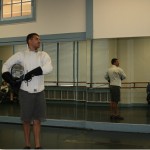
-
Mr. Evans
-
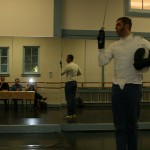
-
Mr. Kalleen
-
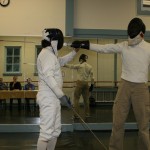
-
Mr. Pacheco Ancheyta examines the guard of Mr. Smith
-
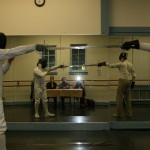
-
Angulo Recto
-
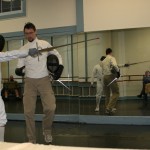
-
Mr. Smith examines the guard of Mr. Pacheco Ancheyta
-
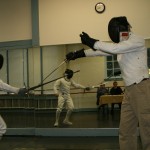
-
Atajo
-
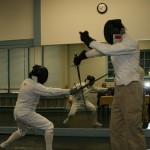
-
Atajo, transversal, and thrust
-
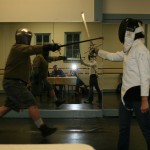
-
Mr. Wright and Ms. Smith
-
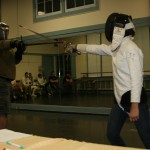
-
Mr. Wright and Ms. Smith
-
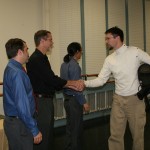
-
Mr. Smith and the Board
-
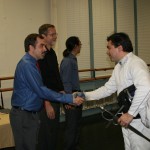
-
Mr. Pacheco Ancheyta and the Board
-

-
Group Photo
Filed as Classical Fencing, Destreza (Spanish swordplay), Fencing, General, Historical Fencing with no replies
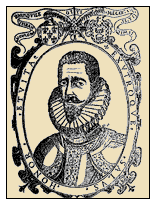
Don Luis Pacheco de Narváez
He is acerbic, often dogmatic, and difficult to like. Pacheco’s work at first glance would not seem to be an ideal metric by which to unify a tradition. Many people reading Pacheco for the first time have a strong negative reaction to the trollish way he jibes at the works of others. He does not resist the urge to throw punches in his prose and perhaps it makes him an early species of today’s internet troll who pokes and annoys others for his own amusement. Reacting to his tone, we might quickly dismiss him but the problem is that Pacheco is also an incredibly gifted technical writer and theoretician who is perhaps the most prolific fencing author in history. Most of the technical information we currently have about La Verdadera Destreza is a direct or indirect result of Pacheco’s work.
Carranza’s work does not contain enough technical material to describe a complete system. Thibault’s work is both extensive and technical but appears to be out of sync with the other authors. Most of the other La Verdadera Destreza authors available are derivative of Pacheco’s core system which means they are in some sense accountable to his examination standards. For this reason I often find myself presenting or defending Pacheco’s position as a common point of verifiable evidence even while I acknowledge that the tradition is broader than a single author.
The classical tradition that trained me enforces a core standard of practice with meticulous care. As an example, the hand in the invitation of second shall be held at a certain height and angle; to do otherwise is incorrect. However, if we examine the historical record, we see a multitude of different examples of the invitation in second and it might seem that this insistence on uniformity would be a compulsion which also borders on trollish antagonism towards the students. Why? What purpose does it serve?
By reducing scope in the school and during the examinations it creates right and wrong answers. That brief state of artificial purity allows students to develop their core skills and to carefully climb within a demanding system from ignorance into technical competence. As the students develop understanding and ability their own questions naturally arise which challenge the purity of the right and wrong answers.
An Instructor candidate should be able to recite the answers in the textbook and teach most of the actions described. The Provost candidates teach at a higher level and might qualify their answers, delve into difficult and broader theory, and occasionally explore concepts outside the textbook. The Master candidate is expected to not only be able to teach the textbook in its entirety but to also know when to leave it aside and justify the reasoning. The mastery of the lesson and execution becomes a personal expression which realizes the tradition as an act of creative art. An answer outside the scope of the book can become correct when good reason and judgment are applied.
William Gaugler’s fencing master’s program was not cloning human versions of his textbook but rather creating a common language and understanding by which a community could work outward to achieve nuanced understanding which could be both broad and deep. This might best describe the position from which Figueiredo wrote his Oplosophia; he has enough knowledge and expertise to master a tradition and yet uses his ability to provide critical expertise on the elements involved which challenges the canon of the tradition itself.
It is within this textbook form that Pacheco’s work shines. We have his proposed testing criteria and a large body of work which we can use to create a uniform standard for examination. A student citing Pacheco in his examination works from a defensible place of canonicity which provides a textbook of right and wrong answers. It forms a common core of theory and practice from which the students may safely learn in an elegant simplicity and ultimately transcend into multi-hued complexity.
Pacheco is not the only voice in our tradition but he is one of the great LVD authors and just as the textbooks in the classical program provide a beginning, mastery involves internalizing the work and seeing beyond the rules into the deeper and changing causes from which they are derived. Studying Pacheco diligently can become a Carrancine exercise in the search for verifiable science which can be taught and demonstrated.
For a Carrancine teacher Pacheco serves as a brilliant starting point, as a tool for teaching and examination, as an exercise in application, and as a historically uniform standard for evaluating knowledge and practice. Pacheco is a ready-made roadway from ignorance, through competence, into mastery. When that path is paired with Carranza’s instructions about teaching, science, art, and ethics we move from creating builders into creating architects.
Filed as Classical Fencing, Destreza (Spanish swordplay), Fencing, General, Historical Fencing, Italian Rapier, Opinion with no replies
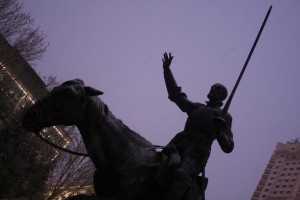
There is no point in dreams if they lack some measure of audacity.
It was January of 2000 and the world had survived the millennium bug. The place was Breckenridge, Colorado and a member of my wife’s family had a cabin near the ski resorts. There at the top of the mountain I got my first bit of instruction in the ancient art of skiing.
The first and last thing I heard was, “Lean forward,” and so I did. I began to slide down the mountain gaining speed. I had no way to steer and no idea what I should be doing. I found myself completely out of control and was headed towards the trees at increasing velocity. Before I painfully crashed I orchestrated a controlled wipe-out into the snow with poles, skis, and limbs all flying in different directions. The remainder of the day was a repeat of the same series of leanings forward with various wipe-outs. I got better instruction and learned how to stop by “snow-plowing”. By the end of the day I had learned how to turn and stop with the skis parallel.
Sometime ago I became interested in the study of incompetence and how incompetent people generally behave. Specifically I was interested in the meta-cognition of incompetence as studied by Justin Kruger and David Dunning who found that incompetent people were unable effectively to evaluate their own competence. This lack of ability to understand personal competence has been called the Dunning–Kruger effect and restated basically it means that incompetent people tend to overestimate their own level of skill.
Link to the study:
https://www.math.ucdavis.edu/~suh/metacognition.pdf
(For an academic study, this is riveting material to read especially as a researcher, teacher, or student of martial arts.)
Compare that to Carranza’s statement, “He who knows most doubts most.” Carranza adds the perfect corollary to the DK effect and uniting the two ideas has given me a basis for moving forward during difficult tasks. (As an example, when a prairie-born Okie is rolling down a mountain with skis tied to his feet.)
The point isn’t to belittle or slander incompetence; we’re all incompetent in some subjects. Instead, my goal was to develop strategies to understand and mitigate my own incompetence by reserving a healthy dose of doubt about my own ability and creating a series of tests to validate my own performance.
I am going to add my own rule which I learned in Breckenridge, “Lean forward.” We can paraphrase Voltaire to arrive at a similar statement, “Never let the perfect be the enemy of the good.” If I had become paralyzed with the fear of the many stumbles, spectacular wipe-outs, and public laughter at my misbegotten antics I might never have learned to ski that day.
We might best understand this as a Medio (or a virtuous mean or balance point as Aristotle and the Destreza authors might describe it). There is absolute perfection at one extreme. At the other extreme is complete incompetence. Between the two extremes is the good work we might do if we just lean forward and accept our imperfection.
We need to teach and practice La Verdadera Destreza to build our skill and to foster a community. But, we also know not all the work has been translated which should be a warning to us to preserve our doubts. Previous attempts have stumbled and fallen quite publicly. Worse, our mistakes may be mocked and picked apart and ridiculed by our peers.
1. Know that your ability to self-evaluate is shaky while you are learning.
2. Preserve a healthy doubt and create meaningful checks to ensure your work is good.
3. Lean forward and be ambitious unto audacity. Don’t let the fear of failure prevent you from producing work.
Filed as Classical Fencing, Destreza (Spanish swordplay), Fencing, General, Historical Fencing, Italian Rapier with no replies
Like many of the stories of my life, this one should start with me being a fool. It was WMAW and assembled there were a collection of instructors trained through Maestro William Gaugler’s fencing program. The Chicago Swordplay Guild wished us to deliver to Maestro Gaugler a gift. Resting inside a carved box was a wooden gladius, a Rudis, of the kind which was traditionally presented to a gladiator who had earned his freedom to become a Rudiarius. Engraved were words expressing their desire that this tradition should persist forever.
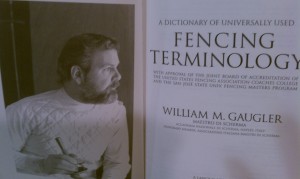
Maestro Gaugler
At the time I thought it was merely a lovely gesture for his years of hard work but this was a young man’s thinking… it was a fool who could not see the message contained therein which we must all face as fencers, teachers, and members of a martial tradition. What I did not know was that Maestro Gaugler was dying and that his days of servitude to the tradition were ending.
In 1979 Gaugler started the San Jose Fencing Master’s Program which harkened back to an older expression of the tradition in which the inquartata and the passata sotto were still taught. It was taught as if the weapons had greater mass than the trainers themselves actually possessed. The parries emphasized defensive power over the quick ripostes favored in sporting competition. It was a school in which we were required to both percussively strike and then slice in our sabre cuts in order to lay open wounds we would never see. The sabre cuts circled from the elbow to generate enough force to deliver powerful cuts while withdrawing our forearms from the threatened space created when the weapon left the line of offense. It was heavily based on Parise’s work which was itself an attempt to protect the Italian tradition. In order to certify the Fencing Master’s program Gaugler brought masters from Italy to witness the exams and they did so expressing their admiration that he had created so authentically an Italian expression of the art.
Gaugler had created a time capsule waiting for the right moment to be opened. Outside of Gaugler’s Italian time capsule competitive fencing had moved in a different direction but a new movement lay on the horizon and the historical fencing community arrived at the end of the millennium. I had been working on historical traditions for over 10 years before I began studying under the masters that Gaugler had trained. The fencing master’s program was based on a martial system which was well-documented but even more compelling for me was a tradition of teaching which was largely unknown outside the school itself. As I began to train, my own understanding of the historical texts and my ability to transmit the material to students began to accelerate. Not only was my own practice getting better but my ability to train an effective historical Italian fencer had begun to blossom.
The Spanish Destreza author Carranza describes the early rudiments of knowledge as trying to write a letter while knowing only ‘A’, ‘B’, and ‘C’. Having found the Gaugler-trained masters I was awash in a rich language which I had never seen before and I was beginning to write fresh prose as I received the hundreds upon hundreds of touches from my students. Every lesson I gave changed the world in some small way and I was creating fencers who were both powerful fencers but also mastering a systematic way of approaching their martial tradition.
Gaugler’s insistence that lesson be the mirror of combat, that our classwork artificially preserve the mass of actual weapons, had created a clean bridge from the classical tradition into the earlier rapier work and the results were impressive. In my younger days I was a competitor in my fencing. I fought for the love I had of friendly play and the joy of the art itself. Fencing is so often an art form that lasts but for a brief shining moment which transcends all our human imperfections to create an instant of perfect time. What a joy it is to be there and to see the light it brings to the world.
Today I more often work on helping others to kindle their own spark. The day will come when I am held to task for what I did to preserve the traditions in my care. Did I create new and useful work? Did I train new fencers and teachers? Have I done everything in my power to ensure the tradition will persist forever?
I am a thing so well out of his place stumbling and making errors in my work as I strive to rebuild the Iberian traditions and protect the Italian ones. In that sense, being a fool is one of my strengths for I persist in striving regardless of my mistakes in the hope that I can do better. Being publicly wrong and taking the bruises required to correct my fumbling is a cost I will pay if it means the traditions endure. I am a fleeting, temporary thing but I am mindfully working to create a new generation of fencers and teachers who will carry the torch forward. The measure of my worth is not the adversaries I have defeated with my tradition but rather the students and teachers I have given to my tradition.
On December 10, 2011 William Gaugler died. Before the doors were closed on his program it had created 18 masters, 31 provosts, and 47 instructors. His gifted Rudis was a message from a grateful community to the Maestro; it contained a release but also a promise that we would carry his burden going forward so that the art would persist. Your work is done Rudiarius; rest easy.
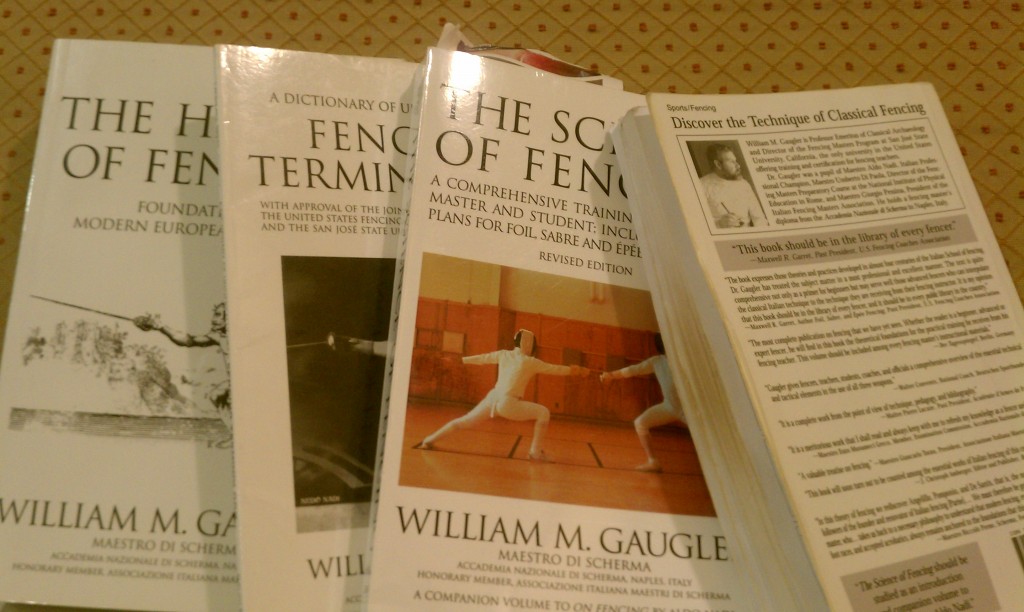
Books by M. Gaugler
































